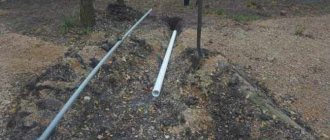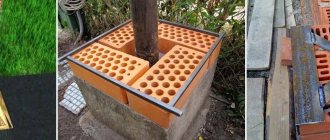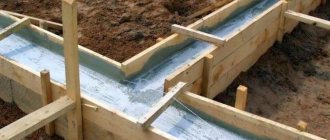For many country residents, the pressing question is how to make a well in their dacha with their own hands, since it is often impossible to solve the issue of water supply to the site and the house in any other way.
Despite the laboriousness of the process, it is quite possible to cope with this work, but you definitely need to get an assistant, since almost all stages of construction are carried out in tandem.
There is a similar article on this topic - Which pump for a well is better to choose?
Do I need permission?
According to the Law of the Russian Federation dated February 21, 1992 N 2395-01 “On Subsoil”, Article 19 allows for drilling wells for one’s own purposes without any permits, provided that no more than 100 cubic meters of liquid from the aquifer rise to the surface per day, and that the source is not centralized.
That is, if you want to obtain water from a source solely for watering your garden, agricultural or household needs, drinking, etc., you do not need to obtain any permits for either a summer house or a private home.
How to find a place?
First you should search for water. The easiest way is to ask your neighbors. If they don't have a source, have they looked for it? If neighbors' attempts are unsuccessful, it will be impossible to find the liquid. You can determine the place where to dig yourself. If there is a source, then before looking for water on your personal plot, you should start from the following factors:
- Terrain.
- Soil type.
- Climatic conditions.
- Nature and plants.
How to determine where is the best place to dig?
The best way to find liquid at a site is through geological exploration.
Having discovered a source or supposed place with water, you should not rush to dig, it is better to check its quality. Does it have any aftertaste, is it cloudy or dirty, etc.
Advice : if you are digging a source for drinking water, it is recommended that you first send it to a laboratory for analysis. The test will be for: microbiology, inorganics, organics, herbicides, radionuclides and pesticides. You can check for fertilizers and petroleum products, iron and manganese.
It is not recommended to dig near the following objects:
- landfills;
- car washes;
- swamps;
- farms and pigsties;
- tanks with sewage and the like.
If the soil in your area is rocky and there are large blocks, then setting up a mine will cause serious difficulties. For this purpose, geological exploration is carried out. This includes:
- studying the nature of the soil and the characteristics of the local rock;
- determining the depth of the source.
Finding water on your own property can make it easier to study the flora. For example, sedge, sedge, and coltsfoot grow mainly in damp areas. If the groundwater is high, then you will see the following trees: spruce, birch, alder. This may be the optimal location.
Important : the search should not be carried out in ravines, river banks, or gutters. In such places, fluid drainage is carried out artificially.
There is another popular way to search for water on your own site. For this, a slingshot made of willow branches is used. It is held in a vertical position, where the aquifer is close, and the tension of the slingshot barrel is felt in your hands. Instead of willow twigs, metal wire is also used, from which 2 equal L-shaped frames are made. If you hold them in a horizontal position with your elbow bent, the frames begin to move and cross where there is liquid.
Making a well at your dacha with your own hands
- Any well on your site will be an element of landscape decor, so it is very desirable not only to build a functioning device, but also to give it a nice appearance that is in harmony with the country house or the landscape of the site.
- To do this, it is not at all necessary to purchase expensive materials or master complex technologies. Conduct an audit of the remaining building materials, determine the style of the future building, and get down to business.
So, here’s how you can decorate a well in your country house with your own hands, without extra costs, using the following materials at hand:
- tree
- brick, stone, remains of cladding
- plastic
- flowers and other plants
Wooden structures can be very diverse. This is a good-quality log house and a gable roof over the well. The entire structure can be made in different styles - rustic, maritime, fairy-tale, oriental, modern.
- The pillars supporting the roof can be made in the form of folklore and fairy-tale characters, gnomes, bears, birds, dragons, and abstract patterns.
- If desired, you can make a wooden well-like image: a pirate chest, a gnome house, a beer barrel, a mill, and more.
- You can make a head out of concrete, decorate it with wild stones and multi-colored round pebbles inserted into fresh plaster. It is good to lay out a blind area of paving slabs or cobblestones and arrange flower beds.
- The chalet style combines decorations made of wood and stone at the same time: the bottom of the head is decorated with stone, most often rounded cobblestones, or savage stone. The roof is wooden, in a simple style.
- The oriental style involves a pagoda-like roof with upturned edges, covered with soft tiles, pillars in the form of dragons intertwined with a floral pattern. In this case, all materials should be only natural , no plastic or other artificial materials.
- Modern plastic is good for decorating a well in the Art Nouveau style: a transparent roof made of colored polycarbonate, openwork metal pillars supporting it, a wrought-iron fence. All this is very well entwined with climbing plants - flowers, vines.
Decoration
Well design
Shaft depth
Conventionally, aquifers can be divided into several horizons. For a full-fledged well, it is enough to dig into the first one. Typically the depth ranges from 5 to 30 meters. Depending on how wells enter the aquifer, dacha wells are divided into 3 types (diagram below):
- Perfect with sump (B).
- Perfect (B).
- Imperfect (A).
In the third case, water inflow is possible through the bottom and side walls. In the second case, exclusively through the walls, and as for the sump, the shaft will be located in the rock. Due to this, the fluid supply increases significantly.
Based on the characteristics of the soil in your area, you need to choose the most affordable method of installing your well.
Types of wells
There are three types that determine the operational supply of water inside a hydraulic structure and the method of its supply to the shaft.
- Wells of imperfect type. This type is constructed so that the shaft does not rest against solid rock. That is, the walls are formed so that the shaft of the structure is immersed in the aquifer by approximately 70%. That is, water is drawn into the well both through the walls of the building and through the bottom.
- Perfect type. This is when the mine shaft rests on solid rock. In this case, water penetrates into the well only through the walls.
- Perfect looking with a sump. The latter is a water collector, which is laid in the lower durable layer. And water enters the structure through the walls of the shaft.
Three types of water wells
What time of year should you dig?
Is there a difference when it's better to dig? Yes. The ideal time of year is late summer and January. To cut a spring in winter, there must be frost for at least three weeks.
Digging during this period has its advantages:
- The groundwater level is very low.
- There is practically no perched water.
- It is easy to calculate the debit, since at this time of year it is minimal.
If you plan to dig yourself, with your own hands, then you need to start in early August in order to be in time before the rainy season.
Important : the selected time of year should be as dry and dry as possible.
Digging technique
Drilling is performed using several technologies:
- open;
- closed;
- mine;
- tubular.
Let's take a closer look at these types of wells.
Open
You can dig a mine in an open way. To do this, dig a hole of the required depth. The diameter of the shaft should be 20 cm larger than the diameter of the reinforced concrete ring. After lowering the concrete products, they must be connected to each other. The joints are also sealed. The resulting space between the walls of the shaft and the ground is filled with earth.
Closed
A summer source can be made in a closed way.
Before digging a well, it is necessary to prepare a hole in the ground up to 2 m deep. A reinforced concrete ring is carefully inserted into it. As it deepens, the installed co-construction will gradually sink down. The second, third rings and so on are carefully mounted on top. The latter should rise above the soil level.
Important ! As new rings are installed, all joints must be sealed.
Construction using this method requires certain skills.
Shakhtny
A shaft that should be strengthened to prevent soil from collapsing. Previously this was done using logs. Currently, the shaft or shaft is reinforced with concrete round rings. As a result, the source is protected from wastewater and pollution.
How to dig a well
The main tool for constructing a well is a shovel, but you will definitely need a bucket or other container to lift the soil to the surface.
It is also necessary to install special lifting mechanisms, for example, a tripod, a winch or a gate mounted on trestles or other devices.
With their help, they not only simplify and speed up the process, but they also serve to prevent the walls from collapsing or shedding when manually pulling the bucket using a rope.
In most cases, especially with crumbling and loose soils, it is justified to choose the option of constructing a well with alternate installation of rings, the algorithm of actions for which is as follows:
- first, the location for the future well is designated and the turf layer of earth is removed;
- Next, the area is fenced to prevent people not involved in digging the well from entering the perimeter;
- prepare a place for dumping earth from the mine, which cannot be located closer than 3 m to the well;
- the first ring is installed along the diameter of the future well, under which the soil is gradually removed, which facilitates its smooth sliding down;
- after the upper edge of the ring is equal to the ground level, a second one is installed on it, and the work is repeated until the boundary of the aquifer is passed;
- then the deepening should be continued by 1-2 m, depending on the depth of the layer, in order to further ensure the required debit.
In some cases, it is justified to pre-fill a concrete knife (or “shoe”), which is made according to the diameter of the rings, and its peculiarity is its triangular shape, due to which the process of passing through soils, especially heavy ones, is more intense.
It is on this that the first ring will be installed, but only after it has gained the required strength.
You can significantly simplify the work of digging a well if you first make a kind of cross, with the help of which you can easily control the accuracy and compliance with the dimensions.
The length of each rail coincides with the diameter of the well, taking into account the thickness of the concrete rings and the required margin for clearance. This tool is especially indispensable for open digging, since in this case there are no other reference points.
Features of digging a well shaft
During the process of digging a well, you must ensure the accuracy of the connection between the rings, so it is recommended to choose products with a special locking connection. But even in this case, it is necessary to fasten between the rings using metal brackets.
The well must first be externally waterproofed using concrete rings, which serves primarily to protect against the ingress of perched water.
Of course, the limited space inside the rings affects the speed of passage, but if you need a shallow well, up to 8-10 m, then this digging option is optimal.
The use of an open method, in which the rings are laid after the shaft has been manufactured, can lead to collapses and, despite the fact that it makes it possible to check the tightness of the connections between the rings on the ground, before they are lowered using a crane or manipulator, it can only be used on dense soils.
Although, if a plastic well for drinking water is being built, then the latter method is more preferable.
In some cases, it is justified to use both methods of digging a well: first, up to a certain level, the work is carried out in an open way, and then with the gradual installation of rings.
Tools
The set of tools and materials may differ depending on what types of wells will be built.
Tools:
- cable;
- homemade winch;
- buckets;
- shovels with short handles;
- ropes;
- wheelbarrow;
- hammer/drill;
- carpentry tools (when working with wood);
- jackhammer;
- scrap;
- ladder;
- flashlight;
- pump;
- insurance;
- level;
- helmet.
Materials:
- reinforced concrete rings;
- cement;
- sand.
Safety precautions
To build a well with your own hands, it is extremely important to follow certain precautions:
- When digging, the head is protected by a helmet.
- Bucket handles must be strong and reliable.
- The rope for lifting the bucket must be strong.
- The carabiner must be reliable.
- From time to time you should check the carabiner, rope and handle on the bucket.
- Digging is done one by one.
- It is necessary to make sure that the ladder is reliable and durable.
- Work should be carried out in strong, high and leak-proof shoes and overalls.
- Reinforced concrete products must be installed very carefully.
- The harness with the stone should be lifted slowly and carefully.
- Insurance required.
- If there is a gas leak, go upstairs immediately.
- Keep children away from the work area.
- Do not dump the raised soil closer than 3 meters from the hole.
- Warn the digger about lifting and lowering objects.
Is it possible to build a well yourself?
To ensure that digging a well with your own hands does not turn out to be a task with many unknowns, before starting work you need to properly plan all the stages with a clear indication of the order of processes, as well as prepare all the necessary tools, materials and devices.
At the first stage, you should decide on the location of the well on the site, and before that, study the hydrological conditions.
Drilling exploratory wells for private construction is not the most rational way, so if there are neighboring farmsteads around, you can ask how the problem of water supply is solved, and if wells are already equipped, then the level of groundwater.
But it is imperative to take into account the geological features of the area: it is only possible to fully rely on data on the occurrence of aquifers in the case of a flat landscape; in other cases, adjustments cannot be avoided.
It should also be taken into account that it is justified to dig a well yourself to a depth of a maximum of 10-15 m, otherwise you cannot do without the use of special equipment, or you will have to opt for a well.
Do-it-yourself well. Video:
Common Mistakes
- A small number of rings.
- If it is necessary to deepen the mine, then you should not dig in one ring from the outside, but rather clean the source.
- If it is necessary to deepen, then the shaft is completely dug.
- Avoid superficial restoration of joints. The seams should be completely cleaned of mortar.
- If the old source is running, it is better to spend money on digging a new one.
- Do not leave seams through which water can leak.
- Do not abandon a dug mine without cover.
How to make a mine from concrete rings?
The process of making and installing rings with your own hands is a labor-intensive stage of work. Reinforced concrete wells are manufactured in the following sequence:
- Marking is being carried out on the site.
- The bottom is leveling out. A diameter of up to 1.5 m is enough.
- The concrete well is immersed after excavation to the height of the ring using a tripod or winch.
- The first ring is mounted, measurements are taken all the time.
- As you go deeper, a second one is installed, and so on. Using a crowbar we level it.
- The well can be sealed from the inside using a rubber band, which is placed in the gap between the rings. If there are loops, they bend inward.
- A filter is installed at the bottom of the source.
- Groundwater protection is carried out. Waterproofing is done using special mastics.
- Before caulking the seams between the rings, you need to connect them with anchors.
Before digging a well by hand, it is necessary to have the exact diameter of the concrete ring. The pit for reinforced concrete wells should be 200 mm wider in width. While digging a hole, be sure to check the level; the shaft must be vertically level. As the hole is dug independently for the reinforced concrete rings, the soil gradually rises upward. Everything happens in stages, the bucket goes down and goes up the winch.
Advice : knowing how to dig a mine at your dacha, you can handle all the work yourself. The well must be waterproofed to protect the source from groundwater penetration.
If a boulder is encountered, it is removed if possible. Although in some cases the mine is filled up and arranged in another place.
Types of wells made of different materials
There are two types of wells, but if we are talking about a structure built by ourselves, then we mean a shaft structure, since a tubular or Abyssinian well is, in fact, a well, so special equipment must be used to drill it.
Of course, you can also do it yourself, but if you hit hard rocks, it will be impossible to drill with a hand tool.
In addition, in dacha plots, it makes sense to install this type of well (in popular parlance, a standpipe) when water is close to the water, which is planned to be used for household needs, for example, irrigation.
The shaft structure is quite wide: on average, its diameter is about 1 m, so when planning to use reinforced concrete rings for wells, you should focus on their size.
With an increase in diameter, the volume of excavation work increases significantly, and doing less is not practical from the point of view of performing the work, since digging in a limited area is not only inconvenient, but may also be technically impossible.
At the initial stage, you should also decide on how the water will be raised to the surface: manually or using a pump.
In the second case, the well can be used as a source of water for a full-fledged automatic water supply system in a suburban area.
Structurally, a mine well consists of several main parts:
- a water intake located in the lower part and serving to collect and accumulate incoming water;
- trunk or shaft (from the latter the name of this type of wells comes) - this is the largest part of the structure. Provides access to water supplies and at the same time serves to protect against soil collapse, as well as water from entering the well. To strengthen the trunk, various materials are used: wooden beams, brick, stone, concrete or plastic rings, concrete for a monolithic structure;
- the well is crowned by its head, protruding above the ground to a height of at least 50-80 cm;
- Mandatory for a well are a lid and a chain with a collar, although the last element may be absent, for example, in the case of organizing automatic water lifting using a pump and pipes.
Despite the fact that traditionally the top is made of wood, a plastic cover for a well is becoming increasingly popular, since this material is more resistant to negative natural factors.
In some cases, as thermal insulation, but primarily for aesthetic purposes, a log house for a well , which is a small superstructure over the head, most often built of wood.
Advantages of using concrete rings
Most often, when building a well with your own hands, concrete rings are used for its trunk, which are quite affordable, reliable and durable.
But in order to avoid the need to involve special equipment in their installation, it is recommended to choose products with low weight, the installation of which can be done manually.
In this case, it is preferable that the dimensions of concrete rings for wells have the following values: internal diameter - up to 1 m, and height within 0.25-0.5 m.
The popularity of concrete rings for constructing a well also has a practical explanation, since using this material, the construction of the structure can be done in stages, the so-called closed method, in which the products are gradually strung as they go deeper.
When using materials such as wood, brick or stone, the amount of work increases dramatically.
In addition, these structures are not completely airtight, which will require increased construction costs, and if timber is used, they are short-lived.
But if you still decide to build a well from timber, then it is better to give preference to a square shape, while the log house should be assembled on the ground, using the cutting technique “in the paw” without leaving any residue.
plastic rings for wells with high performance characteristics and inertness to many substances can compete with concrete products
A shaft made of this material is sealed and durable, and the work will not be particularly difficult due to its low weight.
An affordable option for self-construction of a well is the use of concrete, with which you can build and equip a completely sealed well shaft, and an important advantage is the ability to carry out work as it goes deeper into the ground.
How to seal seams: mine waterproofing
When the well is completely drilled and the rings are all in place, they need to be waterproofed from the inside.
If it will be carried out in wet soils, then coating compounds are recommended. For example, you can use bitumen mastic. She must treat the outside of the rings. This will significantly extend their service life. The joints are additionally coated from the inside.
Concrete shafts are often wrapped with roll insulation, such as dense polyethylene, as waterproofing. Film is much cheaper. However, it is used exclusively from the outside. You need to quickly dig around the rings in a circle and wrap them with film.
Important ! The film will last for several years if you buy a durable one with reinforcement. But it is better to allocate a budget for coating insulation.
Some summer residents resort to additional waterproofing by making a clay castle. This is especially true if clay rises to the surface when digging. It can be used by filling the well from the outside.











